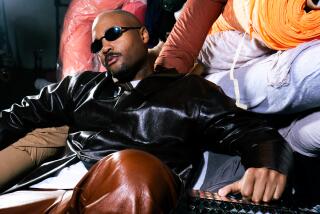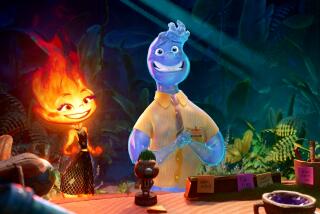Gadgets Include User Attachment
Scott Rose is gaga for his iPod.
“Imagine being in a romance so perfect, you wonder how you ever managed to survive before this person came into your life,” said Rose, a 33-year-old Los Angeles computer consultant. “That’s how I feel about my iPod.”
Rose’s passion for his digital music player stems less from the mysterious chemistry of human devotion than from the calculating precision of Apple Computer Inc. engineers, who designed the iPod to elicit the same sort of warm, gooey feelings most people associate with love.
The tiny player’s curves, for instance, are baby smooth.
“It really begs to be caressed,” said Apple’s Greg Joswiak.
Its reflective stainless steel back demands constant polishing.
“People use it as a mirror,” Joswiak said. “It becomes a reflection of them and their unique taste in music.”
Its white plastic case is “pure.”
All that rhapsody for something that is essentially an unromantic hard drive and a few silicon chips?
Across the consumer electronics industry, traditionally geeky manufacturers are embracing their sensitive side to develop products that evoke feelings, including joy, desire, comfort and nostalgia.
“Technology used to be sold primarily on the basis of functional needs,” said Tim Brown, chief executive of Ideo, a design firm in Palo Alto. “But things that are functional are too easy to copy because companies are all getting access to the same technologies. That’s when meeting emotional needs becomes steadily more important.”
That’s what Hannspree Inc. concluded three years ago when the Taiwanese display manufacturer decided to make its own branded TVs. But instead of churning out cheap LCD screens, Hannspree took a different tack. Last year, it launched a line of 100 TVs, each aimed at different emotional targets. One is shaped like a plush puppy, another like a baseball that is actually made of hand-stitched leather.
“If you saw a TV that looked like a baseball, you’d think it’s fun,” said Michael Galvin, a marketing manager for Hannspree. “And you’d know it’s a gimmick. But when you touch it, it’s both surprising and reassuring. You don’t expect it to be the real thing. But it is, and you remember what it felt like when you held a baseball, you remember when you went to a ballpark. You connect it with whatever baseball means to you. The TV is both visual and tactile, so it’s a much stronger impact.”
In addition to differentiating technologically identical products, emotional design can be a hedge against user frustration. It’s no secret that the novelty of a gadget often is inversely related to its reliability. But when users feel bonded to their devices, they are more likely to consider malfunctions as quirks rather than defects.
“We have love-hate relationships with technology,” said design consultant Donald A. Norman, author of “Emotional Design: Why We Love (Or Hate) Everyday Things.” “I can’t live without my cellphone, but it really annoys me. I’m not in control of when my cellphone rings. That speaks to a lack of trust people have regarding their technology. When I use my computer and everything goes well, the emotion I feel is relief. Relief is not a positive emotion; it’s the lack of a negative one.”
Add to that the fact that gadgets are no longer just about the bits of hardware. Like the iPod, many also wrap in software and services such as Apple’s iTunes, which manages songs and sells music downloads. Combining all three components requires more thoughtful attention to what designers call the “consumer experience.”
“We think of it as a holistic experience,” Sony Corp. design strategist Alex Arie said. “It’s not just the hardware, but also everything surrounding it. It’s how people connect with it in the store. It’s how they open the package when they get home, how they first pick it up, how they use it. It’s the relationship they build with the product over time. We want it to fulfill their desires, to become part of their family.”
Not everyone is as passionate as Arie about design. Sure, design is a differentiator, but some say how much something costs and how well it works are more important.
“First and foremost, people care about functionality,” said Van Baker, consumer electronics analyst at market research firm Gartner Group Inc. “That’s why there are so many pretenders to the iPod throne. They think it’s just about industrial design. In reality, it’s a product that does what I want it to do. The fact that it has a nice design is just a bonus.”
But neurologist Antonio Damasio believes that tapping into emotions is more than just a nice touch. In many cases, he said, emotions help drive decisions. In his studies of patients whose brain injuries impaired their ability to express emotions, Damasio found that many had difficulty making decisions, even though they were able to clearly articulate the pros and cons of various options.
“Some people think it’s best to reason with a cool head,” said Damasio, professor of neurology at the University of Iowa. “Others think they should always follow their feelings. The truth is that emotion is part of the mechanism of reasoning. The lack of it is very detrimental to decision making.”
In other words, emotional design can provide that unknowable something that beckons a person to buy.
Designers such as Arie know that and deploy a variety of methods to persuade consumers to form emotional attachments to their products. They select materials and colors that please the eye, engineer sounds that strike the right emotional chords and mold shapes that invite touch.
Sony’s Liv radio, for example, is designed to appeal to women; the curvy surface is reminiscent of a clutch purse. Liv’s emotional opposite is Sony’s WAT System, a slick black metallic boombox with speakers molded to look like a jet engine’s afterburners.
At their core, the two radios have similar functions. But their emotional appeals are vastly different, said Justin Jakobson, a Sony designer. “The Liv radio is simple, honest and inviting,” he said. “The boombox is pure aggression. It’s loud and scary.”
Part of the objective of emotional design is to repackage mature technology, such as a radio, in ways that make people want to own it. One way to do that is by using novel materials.
Many of today’s products are so mass-produced that they retain little character, said Paul Bradley, a designer at Ideo. “Products today are made from polycarbonates that look their best the day you take them off the shelf,” Bradley said. “After that, they start to deteriorate. They flake, scratch, become dull.”
To counter that, Bradley draws inspiration from musical instruments.
“They have a timelessness to them,” he said. “And they have this handcrafted nature that invites human touch. They invite you to engage and develop an attachment to them.”
For Hewlett-Packard Co., Bradley designed the look for a hand-held digital music mixer that lets users wirelessly control the music on their iPods. He chose a polished, nickel-plated exterior that curves around a user’s hand, like a trumpet, and includes a dark wood logo.
“Inside, it’s digital technology,” Bradley said. “But we made it feel like an instrument that’s handcrafted and detailed. If it were made of plastic, it wouldn’t work. It would be a different object with different characteristics.”
Some designers turn to sound to make emotional statements.
Jim Barton, chief technology officer at TiVo Inc., wanted to create a playful design for the company’s digital video recorder. One of his tools was the sound that the machine generates, such as when users fast-forward through TV shows or select a program to watch.
“We sat down at an electric keyboard one day and we tried a bunch of sounds until we found the right ones,” Barton said. “We felt they should be fun. That was the core principle.”
It wasn’t always so. Until the early 1980s, computers and other devices came in unremarkable, no-frills casings.
“They were metal boxes with knobs, and they looked like scientific instruments because they were aimed at people who were more interested in the technology inside the box,” said Tucker Viemeister, president of Springtime USA, a New York design firm, and chairman of the jury for the 2005 Industrial Design Excellence Awards.
“Then in 1984 the first Macintosh computer came out,” he said. “It was the first designed computer. It had a graphical interface that was fun. It had software that didn’t penalize you if you made a mistake. It had a mouse. And it had this two-in-one design with the display integrated with the computer.”
Apple changed the design paradigm again in 1998, when it introduced its iMac computer in translucent plastic “bondi blue,” followed in 1999 by five candy colors -- blueberry, strawberry, lime, tangerine and grape.
“All of a sudden, companies realized, hey, if people can have different colored cars, why can’t they have different colored computers?” Viemeister said.
Of course, design can cut both ways.
“We had a client that wanted us to pick three or four colors that would stand out and yet appeal to a broad group of people,” Ideo designer Bradley said.
“It was a difficult starting point because colors can be very polarizing. Blue is safe, but it doesn’t always stand out. Yellow stands out, but it’s polarizing. You either really like it or you hate it.”
And sound too has limitations, design consultant and author Norman said. “The problem with music,” he wrote, “is that it can also annoy if it is too loud, if it intrudes, or if the mood it conveys conflicts with the listener’s desires or mood.”
This problem is one frequently faced by designers, not just with sound but with the whole notion of emotional design, Ideo’s Brown said. “You’re talking about reaching people at an emotional level,” Brown said. “The risks of getting it wrong are quite high. Measuring functional performance is easy. Measuring emotional performance is tremendously difficult.”
When it works, though, people just know -- or feel -- it.
More-powerful music players have come on the market since Rose bought his iPod two years ago. When he finds himself in an electronics store, he flirts with buying a new music player, but always returns to his iPod.
“These other products don’t speak to me,” Rose said.
“On the surface, they may look hot and sexy, like the iPod. But after two minutes with the product in my hand, I realize it’s not the iPod. It’s not my soul mate.”






